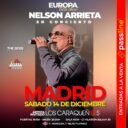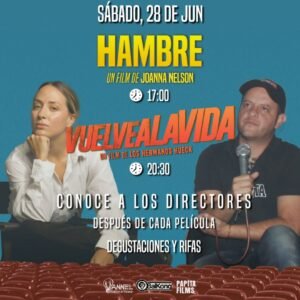El Paisaje Como Puente: Una Línea Venezolana de Continuidad
Naturalia Secular es el título de una exposición colectiva presentada en los espacios de la Universidad Católica Andrés Bello, en Caracas. Con obras de distintas generaciones de artistas venezolanos, la muestra propone una reflexión sobre el paisaje como territorio simbólico, sensible y en constante transformación.

JORGE PIZZANI
Hablar del paisaje en la pintura venezolana es recorrer una de las tradiciones más fértiles y persistentes de nuestra historia visual. Desde los inicios del siglo XX, el paisaje ha sido mucho más que la representación de un entorno, para convertirse en una forma de identidad, de proyección, de deseo, y hasta de consuelo. Por lo que se puede afirmar que es en definitiva una manera de nombrar el país, de imaginarlo, de medirlo, de soñarlo e incluso habitarlo desde el arte.
Los artistas del Círculo de Bellas Artes, influenciados por el impresionismo y el posimpresionismo europeo, abrieron el camino hacia una pintura al aire libre, bajo la luz directa del trópico, permitiendo que el paisaje dejara de ser un simple telón de fondo para convertirse en protagonista. Figuras como Manuel Cabré, el pintor del Ávila, o Pedro Ángel González, con su mirada silenciosa y contenida del entorno, entre otros, contribuyeron a forjar una sensibilidad paisajística que aún hoy resuena en la memoria visual del país.

EDUARDO VARGAS RICO
Con el tiempo, el paisaje se convirtió en un territorio de experimentación formal y simbólica. Desde las abstracciones líricas de los años 50 hasta las geografías fragmentadas del arte contemporáneo, el paisaje ha sido reconfigurado, reducido a estructura o ampliado como metáfora. Pero nunca ha dejado de ser un lenguaje poderoso para hablar del lugar, el tiempo y el cuerpo.
La exposición “Naturalia Secular”, organizada por el Departamento de Artes Visuales de la Fundación Empresas Polar bajo la curaduría de Rafael Arteaga, no propone una cronología ni una confrontación entre generaciones, sino más bien un flujo sensible que nos permita reconocer cómo el paisaje sigue siendo, para muchos artistas, una manera de pensar el país y de pensarse en él. Una constante poética que ha mutado, se ha adaptado, se ha resistido y, al mismo tiempo, nos ha seguido acompañando.
Hoy, el paisaje ya no es solo una vista bonita para pintar. Tampoco es una categoría fija ni un género complaciente. Para muchos artistas contemporáneos, el paisaje es una forma de sentir, de recordar, de hablar de un tiempo y de un lugar. Ya no se trata solo de representar una montaña o un valle, sino de preguntarse qué significa habitar un lugar, qué queda en la memoria, qué se borra o qué se transforma en el territorio que habitamos, ya sea real o imaginado.
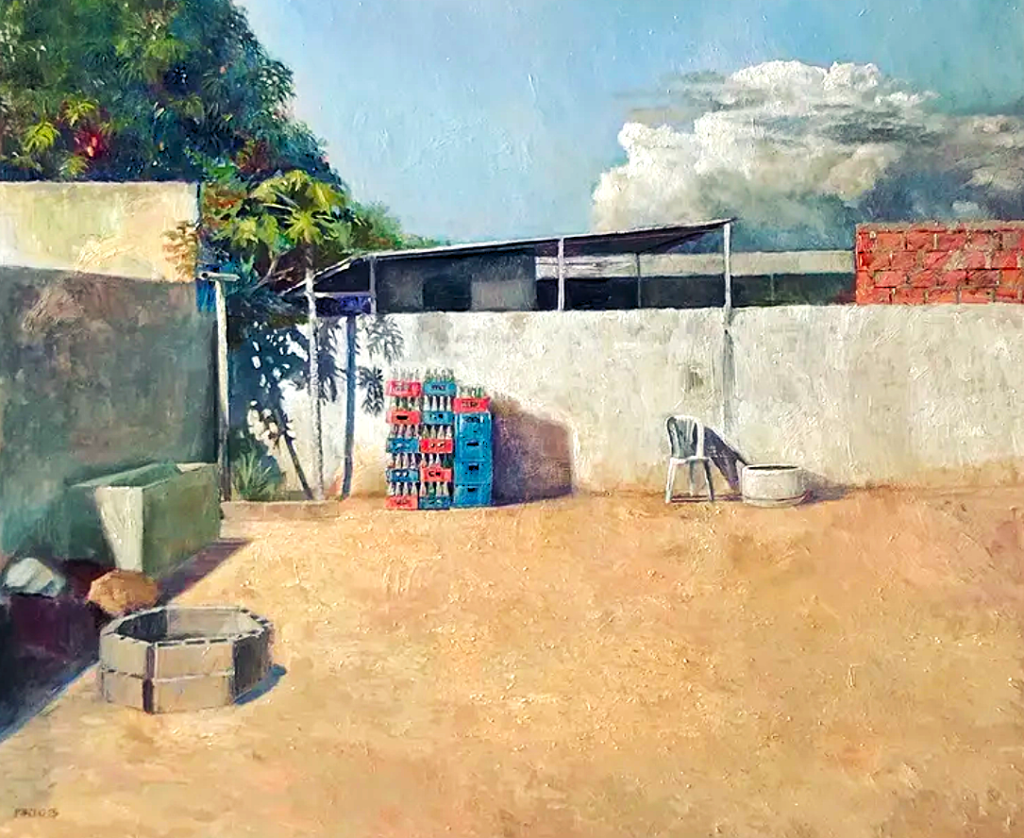
JURGENS PORTILLO
La selección curatorial traza un arco amplio, en el que están presentes artistas como Manuel Cabré, Pedro Zerpa y Ramón Vázquez Brito, figuras históricas que siguen irradiando una sensibilidad viva. Junto a ellos, hay obras de creadores contemporáneos como Adrián Pujol, cuya pintura trabaja la atmósfera como si fuera aliento, en la que lo natural se vuelve una experiencia interior y a la vez una luz que se posa y se diluye. Jorge Pizzani, por su parte, convierte en su pintura el paisaje en una materia viva, pulsante, en su obra hay gesto, memoria y movimiento. Víctor Julio González aborda el paisaje como quien se adentra en el recuerdo, con colores que no gritan, sino que murmuran, para al final con una paleta delicada y envolvente, lograr construir una atmósfera donde la luz y la niebla dialogan en silencio.
Se suman a ellos voces más jóvenes, como la de Eduardo Vargas Rico, cuyas obras parecen rescatadas de una excavación, donde el paisaje se vuelve huella, hallazgo, archivo arqueológico de lo que alguna vez fue. Onai Quiñones en su pintura ensaya una síntesis visual de los elementos naturales, casi como si el paisaje se mirara a sí mismo desde adentro, para convertirse en vibración y silencio. Pedro Medina, desde una mirada aérea y envolvente, propone un paisaje líquido, cartográfico, donde el territorio es más que superficie: es una emoción en movimiento. Jürgens Portillo propone un paisaje que se debate entre lo matérico y lo simbólico, en el que los elementos cotidianos y el ensamblaje de objetos se convierten en una metáfora del territorio, del desgaste y del paso del tiempo.
En tiempos de fragmentación, el paisaje aparece aquí como un puente entre generaciones, entre lenguajes, entre formas de mirar el país y de habitar la pintura. Cada obra en esta muestra es un gesto que cruza el río invisible de la memoria, de la percepción y la emoción. Porque el paisaje no es solo lo que se ve, sino también lo que se recuerda, lo que se imagina, lo que se pierde. En esta travesía compartida entre artistas y espectadores, el paisaje vuelve a ser un territorio común, un reflejo y una promesa. Un lugar desde donde, quizás, se pueda volver a empezar.
Landscape as a Bridge: A Venezuelan Line of Continuity
«Naturalia Secular» is the title of a collective exhibition presented at the spaces of the Andrés Bello Catholic University in Caracas. Featuring works by different generations of venezuelan artists, the show proposes a reflection on landscape as a symbolic, sensitive, and constantly transforming territory.

MANUEL CABRE
To speak of landscape in venezuelan painting is to explore one of the most fertile and persistent traditions in our visual history. Since the early 20th century, the landscape has been much more than the representation of an environment; it has become a form of identity, projection, desire, and even solace. Therefore, it can be affirmed that it is definitively a way of naming the country, of imagining it, measuring it, dreaming it, and even inhabiting it through art.
The artists of the Círculo de Bellas Artes, influenced by european impressionism and post-impressionism, paved the way for open-air painting, under the direct light of the tropics, allowing the landscape to cease being a mere backdrop and become a protagonist. Figures such as Manuel Cabré, the painter of the Ávila, or Pedro Ángel González, with his silent and contained gaze of the surroundings, among others, contributed to forging a landscape sensibility that still resonates in the country’s visual memory today.
Over time, landscape became a territory for formal and symbolic experimentation. From the lyrical abstractions of the 1950s to the fragmented geographies of contemporary art, landscape has been reconfigured, reduced to structure, or expanded as a metaphor. But it has never ceased to be a powerful language for speaking of a place, time, and the body.
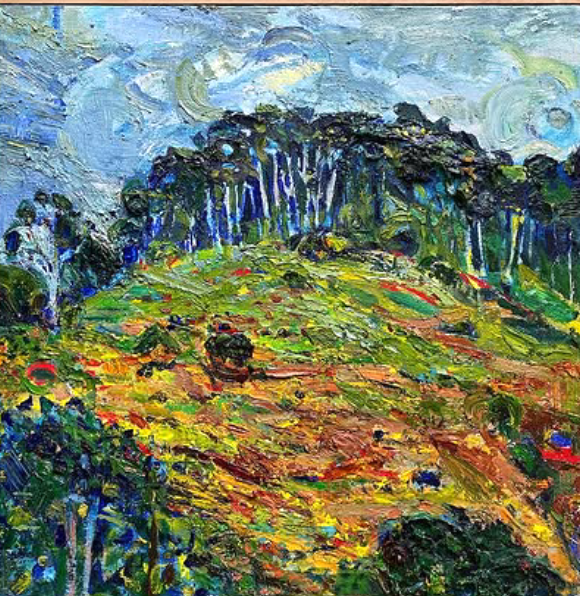
ONAI QUIÑONES
The exhibition «Naturalia Secular,» organized by the Visual Arts Department of Fundación Empresas Polar under the curatorship of Rafael Arteaga, does not propose a chronology or a confrontation between generations. Instead, it suggests a sensitive flow that allows us to recognize how landscape remains, for many artists, as a way of thinking about the country and of thinking about themselves within it. It is a poetic constant that has mutated, adapted, resisted, and, at the same time, has continued to accompany us.
Today, landscape is no longer just a pretty view to paint. Nor is it a fixed category or a complacent genre. For many contemporary artists, landscape painting is a way of feeling, remembering, and speaking of a time and a place. It is no longer just about representing a mountain or a valley, but about asking what it means to inhabit a place, what remains in memory, of what is erased or transformed in the territory we inhabit, whether be it real or imagined.
The curatorial selection draws a broad arc, which includes artists such as Manuel Cabré, Pedro Zerpa, and Ramón Vázquez Brito, among other historical figures who continue to radiate a living sensibility. Alongside them are works by contemporary creators like Adrián Pujol, whose painting works the atmosphere as if it were breath, where the natural becomes an inner experience and at the same time a light that settles and dissolves. Jorge Pizzani, on his part, transforms the landscape in his painting into a living and pulsating matter; in his work there is gesture, memory, and movement. Víctor Julio González approaches his landscape as one who delves into memory, with colors that do not shout but rather whisper, to ultimately achieve with his delicate and enveloping palette, the construction of an atmosphere where light and mist dialogue in silence.

ADRIAN PUJOL
Younger voices are added to them, such as Eduardo Vargas Rico, whose works seem rescued from an excavation, where the landscape becomes a trace, a discovery, an archaeological archive of what once was. Onai Quiñones, in his painting, attempts a visual synthesis of natural elements, almost as if the landscape was looking at itself from within, to become vibration and silence. Pedro Medina, from an aerial and enveloping perspective, proposes a liquid, cartographic landscape, where the territory is more than surface: it is an emotion in motion. Jürgens Portillo proposes a landscape that oscillates between the material and the symbolic, in which everyday elements and the assemblage of objects become a metaphor for the territory, for wear and tear, and for the passage of time.
In times of fragmentation, landscape appears here as a bridge between generations, between languages, between ways of looking at the country and inhabiting painting. Each work in this exhibition is a gesture that crosses the invisible river of memory, perception, and emotion. Because landscape is not just what is seen, but also what is remembered, what is imagined, what is lost. In this shared journey between artists and spectators, the landscape once again becomes a common territory, a reflection, and a promise. A place from which, perhaps, one can start anew.
CARACAS D.C. VENEZUELA
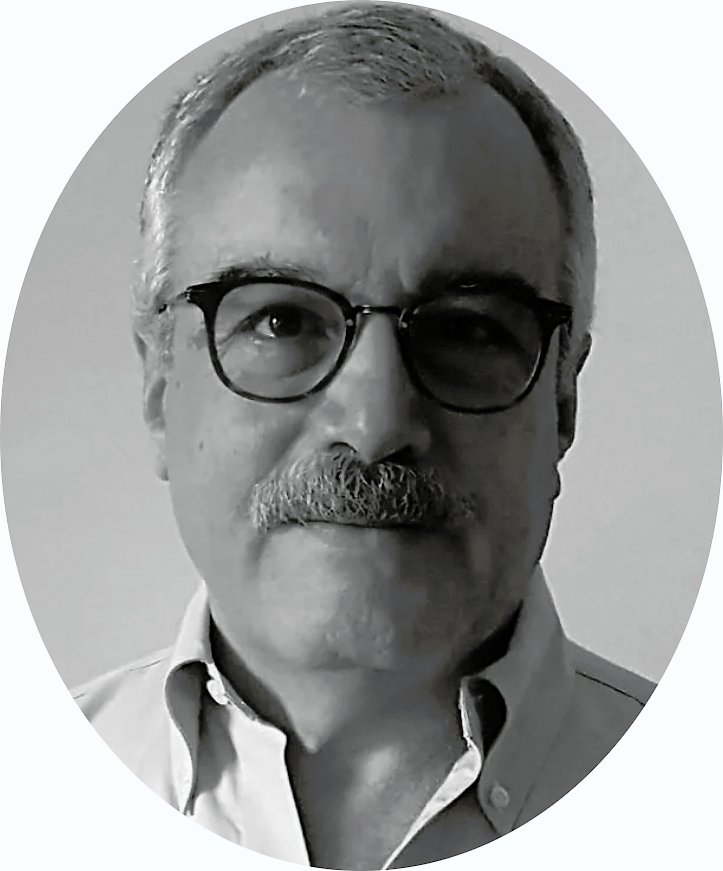
Cesar Sasson
Magíster en Curaduría de Arte
@coleccionsasson
Ciudad de Panamá – Panamá
Junio 2025


